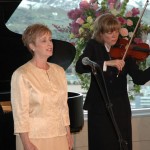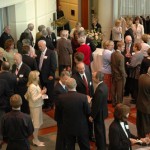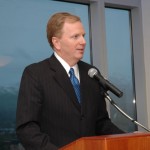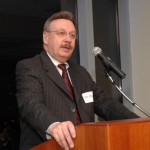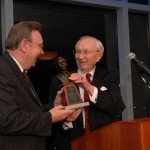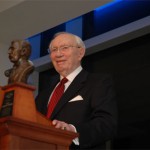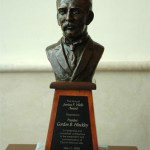Junius F. Wells Award - 2005: Gordon B. Hinckley
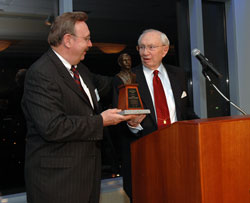
On May 11, 2005 the Mormon Historic Sites Foundation presented President Gordon B. Hinckley with the first annual Junius F. Wells Award.
The event was held at the Wells Fargo Building in downtown Salt Lake City, Utah and was attended by the entire First Presidency, members of the Quorum of the Twelve Apostles, members of the First Quorum of the Seventy, members of the Presiding Bishopric, and members of the General Relief Society Presidency. In addition, many civic and community leaders were in attendance.
The evening included musical performances by Marshall McDonald, Peter Breinholt, Shawna Gottfredson, and Karen Hughes and a video presentation entitled “Remembering Sacred Places” highlighting some of President Hinckley’s efforts in preserving church history.
The Mormon Historic Sites Foundation is honored to pay tribute to the great work that President Hinckley has done for the preservation of the rich heritage of the Church.
Photos
Articles & Resources
History group honors Pres. HinckleyPublished May 12, 2005. Reprinted with permission from the Deseret Morning News.
Deborah Bulkeley and Carrie Moore, Deseret Morning News
President Gordon B. Hinckley of The Church of Jesus Christ of Latter-day Saints has worked hard to preserve historic sites important to his faith, an effort honored by the Mormon Historic Sites Foundation.
“I feel more like a piece of history than a conservator of history,” President Hinckley said after receiving the first Junius F. Wells Award. “I am grateful to see this day.”
Members of the LDS Church know President Hinckley has long been interested in the faith’s early history. During his tenure as church president since 1995, he has led efforts to restore and upgrade a variety of LDS historic sites, particularly in the East.
President Hinckley on Wednesday spoke about Wells, who under the direction of President Joseph F. Smith in 1905, purchased 283 acres in Sharon, Vt., including the Soloman Mack farm where Joseph Smith was born Dec. 23, 1805. Wells erected a granite marker there, 38 1/2 feet high, President Hinckley said: one foot for each year of the LDS prophet’s life.
President Hinckley said the crew couldn’t transport the 40-ton monument across a swampy field to the site. He said when Wells was asked what he was going to do, he responded, “I’m going to pray.”
That night, Hinckley said the temperature dropped enough that the field froze and the horses could cross.
“Today it stands there as pristine and beautiful as ever before,” President Hinckley said of the monument.
In closing he remarked, “To preserve the memory of the past is my humble prayer.”
Kim Wilson, chairman of the board of the independent nonprofit Mormon Historic Sites Foundation, said President Hinckley has perhaps done more to preserve LDS Church history than anyone before him.
“We’ve felt for some time that we’d like to take this moment to honor President Hinckley for his singular effort,” Wilson said. “We’re delighted, President Hinckley, at your vigor.
Wilson said he hoped the award would become an annual way to honor those who work to preserve church history.
Under Hinckley’s direction, a temple was dedicated in Palmyra, N.Y., on April 6, 2000 — the 170th anniversary of the church’s formal organization in nearby Fayette. The temple is close to the boyhood home of church founder Joseph Smith and the grove of trees where he said he saw God the Father and his son, Jesus Christ, in vision.
During the temple construction, major upgrading was done to the church-owned Smith home and farm, as well as to a visitors center and pageant facilities at the nearby Hill Cumorah, where Smith said an angel directed him to a set of gold plates containing an ancient record now known as the Book of Mormon.
Shortly thereafter he announced the Palmyra Temple would be built, and expanding on dreams his own father, Bryant S. Hinckley, had for Nauvoo, Ill., President Hinckley stunned Latter-day Saints with an announcement during his closing address at LDS General Conference on April 4, 1999, that the Nauvoo Temple would be reconstructed.
First built by poverty-stricken Latter-day Saints in the early 1840s, it was dedicated in 1846 just as the bulk of church membership began a major exodus from Nauvoo and migrated west to the Salt Lake Valley. It was destroyed when an arsonist set fire to it in 1848.
The reconstructed temple was dedicated in June 2002 amid crowds in the hundreds of thousands, and the building, along with a major church reconstruction project of early homes and businesses in the tiny town, continues to draw tens of thousands of visitors annually.
More recently, President Hinckley oversaw the expansion and reconstruction of early LDS historic buildings in Kirtland, Ohio, where the faith’s first temple was dedicated in 1836 and still stands (though it is owned by the Community of Christ). The Mormon Historic Sites Foundation was a major partner in that effort, which involved realigning a highway to accommodate visitors in the re-created village of early Kirtland.
A replica of the John Johnson Inn was reconstructed, along with a new visitors center that resembles a 19th century gristmill used by early church member Samuel Whitney. Restoration of the Newel K. Whitney home was also finished, and replicas of a former tannery, ashery and schoolhouse were built.
President Hinckley dedicated the buildings in May 2003, telling church members gathered at the site and via satellite throughout the region that “there is something unique and wonderful about what happened here. Nothing like it has occurred anywhere else in the history of the church, either before or since.”
He felt similarly about an section of Wyoming wilderness the church has now leased from the Bureau of Land Management, known as Martin’s Cove. The area is hallowed ground for Latter-day Saints, who have often heard President Hinckley speak of early converts to the fledgling faith who were making their way to Salt Lake City via handcart when early winter snows trapped them in the cove in the fall of 1856. Nearly 20 percent of the 1,075 emigrants died of exposure before rescue parties reached them.
Today, about 50 older couples now volunteer full-time at the site, part of which was purchased a few years ago by the church to allow construction of a visitors center that chronicles the history of LDS migration along the Mormon Trail through Wyoming.
Worldwide media interest in the Mormon migration across the Great Plains was generated in the spring of 1997, when a re-enactment of the trek was sanctioned by the church to honor the 150th anniversary of the first LDS pioneer party’s trek to the Salt Lake Valley.
President Hinckley dedicated the Mormon Trail Center at Historic Winter Quarters, Neb., the day before the wagon train departed, then directed that a temple be built there, in part to honor early church members who suffered and died during the arduous trip west. It was dedicated in April 2001.
The most recent preservation project that local Latter-day Saints are widely aware of is the retrofitting of the historic Tabernacle on Temple Square, which was dedicated in 1875. Now underway, that project was made possible by construction — under President Hinckley’s direction — of the LDS Conference Center as a larger venue for the faith’s general conferences and weekly Tabernacle Choir broadcasts.
Email: dbulkeley@desnews.com; carrie@desnews.com
Preserving the pastPublished May 21, 2005. Reprinted with permission from the LDS Church News published by the Deseret Morning News.
Shaun Stahle, Church News Staff Writer
For his efforts to preserve sacred Church historic sites and keep in memory the sacrifice and obedience of generations gone by, President Gordon B. Hinckley was honored May 11 with the Junius F. Wells Award by the Mormon Historic Sites Foundation.
“I feel more like a piece of history than a conservator of history,” he said to the delight of approximately 200 gathered in his honor.
“I suppose my interest in (history) comes of the fact that my grandfather was a pioneer,” he said. “He came as a young man across the pains, lost his wife when they were only a few days out, dug her grave and buried her somewhere in what is now Nebraska, and picked up his infant child and brought her into this valley.”
In a video presentation that recounted the various reconstruction efforts in Palmyra, Kirtland, Nauvoo and other sites such as Martin’s Cove and Cove Fort, President Hinckley was recognized for his ability to be “forward thinking while at the same time anchoring the Church with a sense of its rich past.”
Historic sites, it was noted in the video, are not an end, but a means of developing faith, making it possible for future generations to learn of Joseph Smith.
The award is named after Junius F. Wells, who was born in 1854, son of Daniel H. Wells, second counselor to Brigham Young in the First Presidency. Though generally obscure in Church history, Junius Wells is regarded as the father of Church historic site preservation.
His efforts began in 1905, the centennial year of the Prophet Joseph Smith’s birth. Under the direction of President Joseph F. Smith, he purchased 283 acres in Vermont that included the Solomon Mack farm, birthplace of the Prophet. There he erected a magnificent granite marker and built a cottage to recognize the Prophet’s place of birth. Later, he oversaw the erection of monuments at the grave sites of each of the Three Witnesses of the Book of Mormon.
President Hinckley told how Joseph Smith “reposed in (Daniel H. Wells) great confidence,” making him second in command of the Nauvoo Legion, although, at the time, he was not yet a member of the Church.
“Very few people know very much about Junius Wells,” continued President Hinckley. “He was really a very tremendous man in his own right.”
When Junius Wells was 21 years old, President Brigham Young asked him to organize the Young Men’s Mutual Improvement Association. Later on, at age 50, Brother Wells was sent to do something to honor the memory of the birth of the Prophet.
“And so, Junius F. Wells went back to Vermont. He had a great and marvelous dream of what he could do,” President Hinckley said. After purchasing the Solomon Mack homestead, he traveled over Vermont until he found a quarry with a very choice piece of granite. It was cut and finished in an obelisk shape 38 1/2 feet long, one foot for each year of the Prophet’s life.
President Hinckley recounted the “tremendous task” of moving the monument from the South Royalton railroad station up the hill 300 feet on dirt roads to what was then known as Dairy Hill of the old Solomon Mack farm.
“They built a wagon with steel rims 20 inches wide and an 8-inch axle and loaded this huge piece of granite weighing 40 tons, and began to move it, first with six horses, then 12 horses, then 20, and finally 22 horses pulled that load up the hill,” he said.
When the wagon became bogged down in a swampy field, and every effort to free the wagon failed, people asked Junius Wells, “What are you going to do?”
“He said he was going to pray,” continued President Hinckley. “He pleaded with the Lord and told Him how he was stuck and didn’t know what to do.”
During the night, temperatures that had been very mild, dropped to below freezing, solidifying the swamp, making it possible for the horses to pull the monument up the hill.
A device was rigged up to put the monument up straight. “That is where it stands as it enters the third century of its position there,” President Hinckley said.
Later in life, having never accumulated much money, Junius Wells felt it his daily duty to read to a blind woman.
“Thanks be to the Lord for such men as Junius F. Wells,” said President Hinckley.
The Mormon Historic Sites Foundation is a nonprofit organization aimed at preserving significant Church historical sites. Its Web site is: mormonhistoricsites.org.
E-mail to: shaun@desnews.com

